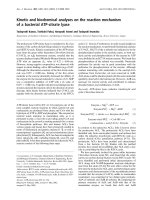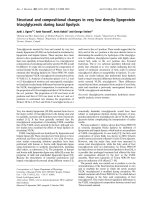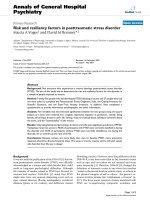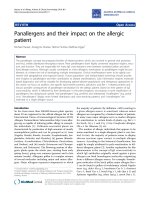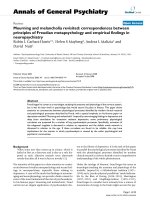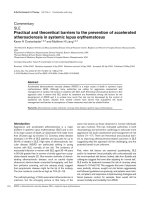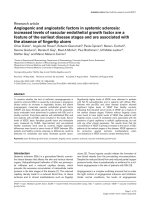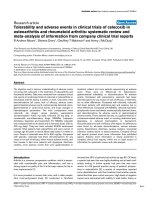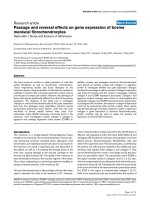Báo cáo y học: "MLN51 and GM-CSF involvement in the proliferation of fibroblast-like synoviocytes in the pathogenesis of rheumatoid arthritis" pps
Bạn đang xem bản rút gọn của tài liệu. Xem và tải ngay bản đầy đủ của tài liệu tại đây (879.32 KB, 11 trang )
Open Access
Available online />Page 1 of 11
(page number not for citation purposes)
Vol 8 No 6
Research article
MLN51 and GM-CSF involvement in the proliferation of
fibroblast-like synoviocytes in the pathogenesis of rheumatoid
arthritis
Jinah Jang
1
, Dae-Seog Lim
2
, Young-Eun Choi
1
, Yong Jeong
2
, Seung-Ah Yoo
3
, Wan-Uk Kim
3
and
Yong-Soo Bae
1,2
1
Department of Biological Science, Sungkyunkwan University, 300 Cheoncheon-dong, Suwon, Gyeonggi 440-746, Korea
2
Division of DC Immunotherapy, CreaGene Research Institute, Aramson Plaza, 164-7 Poi-dong, Kangnam-gu, Seoul 135-960, Korea
3
Division of Rheumatology, Department of Internal Medicine, School of Medicine, Catholic University of Korea, St Vincent Hospital, 93 Chi-dong,
Suwon, Gyeonggi 442-723, Korea
Corresponding author: Yong-Soo Bae,
Received: 15 May 2006 Revisions requested: 8 Jun 2006 Revisions received: 7 Aug 2006 Accepted: 14 Nov 2006 Published: 14 Nov 2006
Arthritis Research & Therapy 2006, 8:R170 (doi:10.1186/ar2079)
This article is online at: />© 2006 Jang et al.; licensee BioMed Central Ltd.
This is an open access article distributed under the terms of the Creative Commons Attribution License ( />),
which permits unrestricted use, distribution, and reproduction in any medium, provided the original work is properly cited.
Abstract
Rheumatoid arthritis (RA) is an inflammatory autoimmune
disease of unclear etiology. This study was conducted to identify
critical factors involved in the synovial hyperplasia in RA
pathology. We applied cDNA microarray analysis to profile the
gene expressions of RA fibroblast-like synoviocytes (FLSs) from
patients with RA. We found that the MLN51 (metastatic lymph
node 51) gene, identified in breast cancer, is remarkably
upregulated in the hyperactive RA FLSs. However, growth-
retarded RA FLSs passaged in vitro expressed small quantities
of MLN51. MLN51 expression was significantly enhanced in the
FLSs when the growth-retarded FLSs were treated with
granulocyte – macrophage colony-stimulating factor (GM-CSF)
or synovial fluid (SF). Anti-GM-CSF neutralizing antibody
blocked the MLN51 expression even though the FLSs were
cultured in the presence of SF. In contrast, GM-CSF in SFs
existed at a significant level in the patients with RA (n = 6), in
comparison with the other inflammatory cytokines, IL-1β and
TNF-α. Most RA FLSs at passage 10 or more recovered from
their growth retardation when cultured in the presence of SF.
The SF-mediated growth recovery was markedly impaired by
anti-GM-CSF antibody. Growth-retarded RA FLSs recovered
their proliferative capacity after treatment with GM-CSF in a
dose-dependent manner. However, MLN51 knock-down by
siRNA completely blocked the GM-CSF/SF-mediated
proliferation of RA FLSs. Taken together, our results imply that
MLN51, induced by GM-CSF, is important in the proliferation of
RA FLSs in the pathogenesis of RA.
Introduction
Synovial tissue from healthy individuals consists of a single
layer of synovial cells without infiltration of inflammatory cells.
In rheumatoid synovial tissue, lymphocytes and macrophages
are recruited and activated, and these activated macrophages
release high concentrations of inflammatory cytokines. In
response to these cytokines, synovial fibroblasts proliferate
vigorously and form villous hyperplastic synovial tissues. These
fibroblasts secrete inflammatory mediators, which further
attract inflammatory cells and stimulate the growth of the syn-
ovial fibroblasts and vascular endothelial cells [1]. These acti-
vated macrophages and fibroblasts produce tissue-degrading
proteinases [2]. Thus, invasive hyperplastic synovial tissue,
termed pannus, is directly responsible for the structural and
functional damage to the affected joints. Therapeutic interven-
tion against rheumatoid arthritis (RA) could aim at any one of
the aforementioned steps, but the driving mechanisms under-
lying this process are largely unknown. Impaired regulation of
apoptosis has been associated with RA [3-5]; however, apop-
tosis of synovial cells has been identified in rheumatoid
BmDC = bone marrow-derived dendritic cell; bp, base pairs; DC = dendritic cell; DMEM = Dulbecco's modified Eagle's medium; FCS = fetal calf
serum; FLS = fibroblast-like synoviocyte; GM-CSF = granulocyte – macrophage colony-stimulating factor; IL = interleukin; mAb = monoclonal anti-
body; MLN51 = metastatic lymph node 51; OA = osteoarthritis; RA = rheumatoid arthritis; SF = synovial fluid; siRNA = small interfering RNA; TNF
= tumor necrosis factor.
Arthritis Research & Therapy Vol 8 No 6 Jang et al.
Page 2 of 11
(page number not for citation purposes)
synovium [6,7], which suggests that synovial tissue hyperpla-
sia may be a result of cell proliferation rather than apoptotic
cell death [8-10].
This study was initiated to address the molecular characteriza-
tion of fibroblast-like synoviocyte (FLS) hyperproliferation in
RA pathogenesis. We used cDNA microarray technology to
identify genes related to the proliferation of RA FLSs. We
found that the expression of the MLN51 (metastatic lymph
node 51) gene was markedly enhanced in RA FLSs when cul-
tured in the presence of the RA synovial fluid (SF). MLN51
was first identified in breast cancer cells, and the same inves-
tigators subsequently reported that MLN51 associates with
exon junction complexes in the cell nucleus and remains stably
associated with mRNA in the cytoplasm [11,12]. Recently, the
interactions of MLN51 with other exon junction complex com-
ponents, a clamping mechanism on mRNAs, and some addi-
tional biological functions of MLN51 in the exon junction
complex core have been identified and addressed [13-15].
Our series of experimental results have demonstrated that
MLN51 is important in the hyperproliferation of RA FLSs in the
presence of granulocyte – macrophage colony-stimulating
factor (GM-CSF) in SF. These results strongly suggest that
the MLN51 gene would be an ideal target for the development
of new RA therapeutics.
Materials and methods
Isolation and establishment of RA FLSs from patients
with RA
FLS cells (designated RA s-2, 2–6, 2–14, 2–18, 2–36 and 2–
38) were prepared from synovectomized tissue of six patients
with RA undergoing joint replacement surgery at the Kangnam
St Mary Hospital, Catholic University of Korea, Seoul, Korea.
Institutional Board Approval (IRB) and informed patient con-
sent were obtained for each enrolled participant. The mean
age of the patients was 43.7 years and their disease duration
was greater than 24 months. The patients had visible joint ero-
sions by radiography of the hand, and all satisfied the diagnos-
tic criteria of the American College of Rheumatology (formerly
the American Rheumatism Association) for the classification of
RA [16]. RA FLSs 2–14, 2–18, 2–36 and 2–38 among the
above FLSs could be subjected to Western blot analysis
because their sample amounts were sufficient. RA FLSs were
prepared as described previously [17-19]. In brief, synovial tis-
sues were minced into pieces 2 to 3 mm in size and treated for
4 hours with 4 mg/ml type 1 collagenase (Worthington Bio-
chemicals, Freehold, NJ, USA) in DMEM at 37°C in 5% CO
2
.
Dissociated cells were centrifuged at 500 g for 10 minutes
and were resuspended in DMEM supplemented with 10%
FCS, 2 mM L-glutamine, 100 U/ml penicillin and 100 μg/ml
streptomycin. Suspended cells were plated in 75 cm
2
culture
flasks and cultured at 37°C in 5% CO
2
. Medium was replaced
every 3 days, and once the primary culture had reached con-
fluence, cells were split weekly. Cells at passages 5 to 8 were
morphologically homogenous and had the appearance of
FLSs with typical bipolar configuration under inverse micros-
copy (less than 2.5% CD14
+
, less than 1% CD3
+
and less
than 1% CD19
+
in flow cytometry analysis) [17]. Osteoarthri-
tis (OA) FLSs (designated OA 2–43, 2–46 and 2–47) were
used as controls and were prepared from the synovial tissues
of three confirmed and enrolled patients with OA. Synovial
fluid samples were obtained from the knee joints of different six
patients with active RA.
Generation of mouse bone marrow-derived dendritic
cells
Immature bone marrow-derived dendritic cells (BmDCs) were
generated from bone marrow precursor cells of DBA/1J mice
(obtained from the Jackson Laboratory, Bar Harbor, ME, USA)
as described previously [20]. In brief, bone marrow cells were
harvested from the femurs and tibias of mice and plated in
RPMI-1640 medium supplemented with 10% FBS, 50 μM 2-
mercaptoethanol, and high-dose (200 U/ml) murine GM-CSF
(Endogen, Inc., Cambridge, MA, USA). The medium was
changed every other day. Seven days later, non-adherent cells
(immature DCs) were harvested by gentle washing with warm
PBS. For DC maturation, cells were stimulated for 24 hours
with TNF-α (500 U/ml; Endogen) or with lipopolysaccharide
(E. coli, 0127:B8; 1 μg/ml; Sigma-Aldrich, St Louis, MO,
USA) together with anti-CD40 (clone 3/23 or HM40, 5 μg/ml;
BD Pharmingen, San Jose, CA, USA). The purity and matura-
tion status of DCs were analyzed by a flow cytometer (FACS-
Calibur; BD Biosciences, San Jose, CA, USA) with the use of
fluorescein isothiocyanate-conjugated CD44, CD80, CD86,
CD205 and MHC II mAbs or phycoerythrin-conjugated
CD11c, CD40 and ICOSL mAbs (BD Pharmingen, San
Diego, CA, USA). Data were analyzed with Cell Quest
Software.
DC cell line
BC-1 cells, from the DC cell line generated from BALB/c
mouse spleen [21,22], were kindly provided by Dr Onoe (Insti-
tute for Genetic Medicine, Hokkaido University, Sapporo,
Japan). BC-1 cells were cultured and expanded in Iscove's
modified Dulbecco's medium containing 10% FCS, 30% NIH/
3T3 culture supernatant, and 10 ng/ml mouse recombinant
GM-CSF. Cultured cells exhibit an immature DC phenotype.
cDNA microarray analysis of rheumatoid arthritis
fibroblast-like synoviocytes
Two types of immunologic cDNA microarray chip, namely
HI380 and MI380 (Creagene Inc., Seoul, Korea) described
previously [23], were used in this study (MI380 microarray
data were not shown in the present report. Total RNA was
extracted with Trizol reagent (Invitrogen, Carlsbad, CA, USA)
and purified by using the RNeasy total RNA isolation kit (Qia-
gen, Valencia, CA, USA) in accordance with the manufac-
turer's instructions. The gene expression profile of human
RAFLSs and mouse BmDCs were analyzed with the HI380
Available online />Page 3 of 11
(page number not for citation purposes)
and MI380 microarray chips, consisting of 384 human and
mouse cDNA clones, respectively. Total RNA (20 μg) was
reverse-transcribed in the presence of Cy-3-conjugated or Cy-
5-conjugated dUTP (Amersham Pharmacia Biotech, Piscata-
way, NJ, USA), using SuperScript II and oligo(dT)
18
primer
(Invitrogen) in a reaction volume of 20 μl in accordance with
the method suggested by the manufacturer. After the labeling
reaction for 1 hour at 42°C, unincorporated florescent nucle-
otides were cleaned up with a Microcon YM-30 column (Milli-
pore, Bedford, MA, USA). The Cy-3-labeled and Cy-5-labeled
cDNA probes were mixed together and hybridized to a micro-
array slide. After incubation overnight at 65°C, the slide was
washed twice with 2 × SSC containing 0.1% SDS for 5 min-
utes at 42°C, once with 0.1 × SSC containing 0.1% SDS for
10 minutes at room temperature, and finally with 0.1 × SSC
for 1 minute at room temperature. Slides were dried by centrif-
ugation at 650 r.p.m. for 5 minutes. Hybridization images on
the slide were scanned with a Scanarray lite (Packard Bio-
science, Boston, MA, USA) and analyzed with GenePix Pro3.0
software (Axon Instruments, Union City, CA, USA). Three sep-
arate and independent experiments were performed and the
ratio of Cy-3 and Cy-5 signal intensities was calculated for
each spot. These ratios were log
2
-transformed and normalized
by subtracting the average of log
2
(Cy-3/Cy-5) values for inter-
nal control genes by using Excel (Office 2003; Microsoft
Corp.) [24]. For each gene, the mean values were then calcu-
lated and a twofold difference was applied to select upregu-
lated or downregulated genes in RA/OA FLSs or immature
DC/bone marrow progenitors.
Semiquantitative RT-PCR
To confirm the upregulation or downregulation of the selected
gene (MLN51) on the microarray analysis and the expression
of MLN51 after siRNA transfection, total RNAs were extracted
from RA FLSs with Trizol reagent (Invitrogen) and purified with
an RNeasy total RNA isolation kit (Qiagen) in accordance with
the manufacturer's instructions. Total RNA (1 μg) was mixed
with 50 μM oligo(dT)
20
, and 10 mM dNTP mixture, heated at
65°C for 5 minutes, and placed on ice for at least 1 minute.
Then 10 × RT buffer (25 mM MgCl
2
, 0.1 M dithiothreitol, RNa-
seOUT™ (40 U)) and 1 μl of SuperScript™ III reverse tran-
scriptase (200 U/μl; Invitrogen) were added, and the mixture
was incubated at 42°C for 1 hour. The reaction was termi-
nated by incubation at 75°C for 5 minutes followed by chilling
on ice. The PCR was performed with the cDNA as template
and certain gene specific-primers.
The following primers were used in this study: hMLN51 for-
ward, 5'-AAGACACCGAGGACGAGGAATC-3', hMLN51
reverse, 5'-CCTTCCATAGCTTTCGCTGACG-3', product
size 600 base pairs; mMLN51 forward, 5'-TCCCTGCCCT-
GCCCTGACTTTA-3', mMLN51 reverse, 5'-CCTCGCGT-
GCTGTGGGAACTCT-3', product size 800 bp; and
glyceraldehyde-3-phosphate dehydrogenase (GAPDH) for-
ward, 5'-CCACAGTCCATGCCATCAC-3', GAPDH reverse,
5'-TCCACCACCCTGTTGCTGTA-3', product size 500 bp.
The initial cDNA content in each sample was normalized with
the amount of GAPDH. Amplification reactions were per-
formed in a 20 μl volume with 5 or 10 ng of each cDNA on a
Perkin-Elmer DNA thermocycler 9600 Prism for 35 cycles.
The PCR reactions were separated on 1.2% agarose gels and
stained with ethidium bromide.
Measurement of cytokine levels in rheumatoid arthritis
synovial fluid
IL-1β and TNF-α were measured in the SFs with the Human
Cytometric Bead Array (BD Pharmingen, San Diego), and
GM-CSF was measured with the human ELISA kit (Endogen)
in accordance with the manufacturer's instructions.
Western blot analysis
RA FLS samples were lysed in boiled buffer containing 1%
SDS. Each sample, containing a normalized amount of total
protein (about 30 μg of protein), was separated by 10% SDS-
PAGE and transferred to a nitrocellulose membrane. This was
then immersed in blocking buffer (5% skimmed milk and 0.1%
Tween 20 in PBS, pH 7.4) for 1 hour at room temperature and
incubated with anti-hMLN51 rabbit serum (1:1,000 dilution)
and anti-GAPDH (1:5,000 dilution) or anti-α-tubulin (1:5,000
dilution) in blocking buffer overnight at 4°C. Anti-hMLN51
serum was obtained from rabbits immunized with recombinant
hMLN51 protein. After the incubation, the membrane was
probed with horseradish peroxidase-labeled anti-rabbit IgG
antibody (1:5,000 dilution) in PBS (containing of 0.05%
Tween 20 and 5% skimmed milk powder) for 30 minutes at
room temperature. The proteins in the membrane were
detected by enhanced chemiluminescence (Amersham, Little
Chalfont, Bucks., UK) and bands were detected by autoradi-
ography with X-ray film (Fujifilm).
Treatment of rheumatoid arthritis fibroblast-like
synoviocytes with synovial fluid, cytokine or neutralizing
antibodies
RA FLSs were cultured in 12-well plates in high-glucose
DMEM supplemented with 10% FBS at 37°C in a 5% CO
2
humidified incubator. For SF and cytokine treatments, RA
FLSs were treated with SFs serially diluted in culture medium.
Inflammatory cytokines (IL-1β and TNF-α; 100 ng/ml of each)
and the growth factor (GM-CSF; 10 or 100 ng/ml) were
obtained from PeproTech (Rocky Hill, NJ, USA) or BD
Pharmingen (San Diego). Neutralizing monoclonal antibodies
against GM-CSF (BVD2-23B6, IgG2a; 300 ng/ml), IL-1β
(AS10, IgG1; 500 ng/ml) and TNF-α (MAb1, IgG1; 2 μg/ml)
were purchased from BD Pharmingen (San Diego). RA FLSs
were preincubated with these neutralizing antibodies for 1
hour. The trypan blue exclusion method was used for the eval-
uation of cell proliferation during all experiments.
Arthritis Research & Therapy Vol 8 No 6 Jang et al.
Page 4 of 11
(page number not for citation purposes)
siRNA synthesis and transfection
siRNA synthesis was performed with the Silencer™ siRNA
Cocktail Kit (RNase III; Ambion Inc., Austin, Texas, USA). The
siRNA sequence was used for targeted silencing of human
MLN51 (GenBank accession number NM007359
) and
mouse MLN51 (GenBank accession number AJ292072
). The
oligonucleotides used for the dsRNA synthesis were, in
hMLN51, 5'-TAATACGACTCACTATAGGGTACTCGTAA-
GATGGCGGACCGG-3' and 5'-TAATACGACTCACTAT-
AGGGTCCGTCCCCACTTTGCCTC-3', and in mMLN51, 5'-
TAATACGACTCACTATAGGGTACTCGTAAGATGGCG-
GACCGG-3' and 5'-TAATACGACTCA CTATAGGG-
TACTCTGCCTCTCCCCAGTCAC-3'. The siRNA sequences
were selected in size ranging from 228 to 686 bp, as
described previously [25,26]. The siRNA synthesis was per-
formed in accordance with the manufacturer's protocol. Non-
silencing or negative control siRNA (Silencer Negative Control
no. 2 siRNA; Ambion Inc.) is an irrelevant siRNA with random
nucleotides and no known specificity. RA FLSs (RA 2–14, at
passage 5; 10
4
per well) and BC-1 cells (10
4
per well) were
seeded in 24-well plates in DMEM supplemented with 10%
FBS and Iscove's modified Dulbecco's medium (containing
10% FCS), respectively. The cells were transfected with the
siRNA (4 μg) on the next day, with the GenePORTER 2 Trans-
fection reagent™ (Gene Therapy Systems, San Diego, CA,
USA) in accordance with the manufacturer's protocol. At 24
hours after transfection, fresh culture medium was added to
the medium. Cells were harvested every day and counted.
Total RNA extracted from the transfected cells was used to
perform semiquantitative RT-PCR.
Statistical analysis
The results are expressed as means ± SD. The Mann – Whit-
ney U test was used for all statistical analysis. p < 0.05 was
considered significant.
Results and discussion
RA is a heterogeneous autoimmune disease. However, these
heterogeneous chronic diseases were recently able to be
monitored in line with their gene expression patterns by micro-
array-based molecular studies [27]. The histology of RA
affected joints indicates chronic inflammation with hyperplasia
in the synovial lining cells. It is now well established that FLSs
actively participate in RA synovitis and that FLSs in RA joints
aggressively proliferate to form a pannus, eventually destroy-
ing articular bone and cartilage [28,29]. Several cytokines,
such as IL-1β, TNF-α and IL-6, have been described in asso-
ciation with the proliferative response of FLSs. In trials of these
therapeutic agents, however, responses were not achieved in
a significant proportion of the patients, suggesting that some
important factor(s) still remain to be discovered.
To our knowledge this report is the first demonstration that the
MLN51 is essential for the hyperproliferation of RA FLSs in
line with GM-CSF signaling in RA pathogenesis. Our results
show that the SF-mediated growth of RA FLSs was markedly
blocked by anti-GM-CSF neutralizing antibody, and addition-
ally that growth-retarded RAFLSs recovered their proliferative
capacity by the addition of GM-CSF. These results indicate
that GM-CSF in SF is important in the hyperproliferation of RA
FLSs. In contrast, in the microarray analysis, semiquantitative
RT-PCR and Western blot analysis experiments, we found that
the MLN51 was consistently overexpressed in the hyperactive
RA FLSs at low passages or the RA FLSs cultured in the pres-
ence of SF. MLN51 knock-down by siRNA completely
blocked the GM-CSF/SF-mediated proliferation capacity of
RA FLSs, suggesting that the MLN51 gene is strongly
involved in the pathogenesis of RA.
We extracted total RNA from RA FLSs and OA FLSs, which
were labeled by cDNA synthesis and ultimately hybridized to a
HI380 microarray containing 384 cDNA clones. The differen-
tial hybridization was performed with Cy-5-labeled RA cDNA
and Cy-3-labeled OA cDNA probes. Through the microarray
analysis, we found that MLN51, a novel gene in association
with RA, was markedly upregulated among the many upregu-
lated genes selected on the basis of their immunologic char-
acteristics (Table 1). MLN51 overexpression in RA FLSs was
confirmed by RT-PCR analysis with three different RA FLS
samples (Figure 1a) and by Western blot experiments with
additional three different RA FLS samples (Figure 1b).
We next investigated whether SFs have an effect on the
growth rate of RA FLSs, what kinds of factors in the SFs are
involved in the proliferation of RA FLSs, and whether the fac-
tors have a role in the expression of MLN51. We determined
the growth kinetics of FLSs at different passages and SF-
treated RA FLSs. The RA FLSs at passage 11 showed obvi-
ous growth retardation (Figure 2a, left panel); however, the
same sample clearly recovered from its growth retardation
when cultured in the presence of 10-fold-diluted SF (Figure
2a, right panel). We next quantified inflammatory cytokine lev-
els in SFs (Figure 2b). The results indicated that GM-CSF in
all SFs from six patients with RA exists at nearly equal levels,
in contrast with other inflammatory cytokines (such as IL-1β
and TNF-α). We found that MLN51 expression in RA FLSs
was upregulated in mRNA level (Figure 2c, left panel) and pro-
tein level (Figure 2d, left panel) by treatment of cultures not
only with SFs but also with GM-CSF. The upregulation of
MLN51 by GM-CSF treatment was also confirmed in six differ-
ent RA FLS samples by RT-PCR (s-2, 2–6 and 2–14; Figure
2c, right panel) and by Western blot analysis (2–18, 2–36, 2–
38; Figure 2d, right panel). Moreover, in both RA FLS samples
(2–18 and 2–38), the MLN51 protein expression was
enhanced by GM-CSF treatment in a dose-dependent manner
(Figure 3). These results strongly suggest that the growth rate
recovery of RA FLSs by SF or GM-CSF is associated with the
expression of MLN51.
Available online />Page 5 of 11
(page number not for citation purposes)
There are many kinds of different cytokines and growth factors
in the RA joint microenvironments. To identify factors having an
effect on the growth of RA FLSs, we investigated the inflam-
matory cytokines and growth factors on the growth of RA
FLSs (2–14) in vitro. The results indicated that GM-CSF and
TNF-α may have an effect on the growth rate recovery of the
high-passage-number RA FLSs. GM-CSF and TNF-α treat-
ment resulted on approximately 2.0-fold and 1.3-fold
increases in the proliferation of RA FLSs, respectively,
compared with that of untreated controls (Figure 4a). These
results support the notion that resident joint cells (chondro-
cytes and synovial fibroblasts) produce GM-CSF in culture in
response to TNF-α and IL-1β [30,31]. However, our result
showed that IL-1β did not induce active proliferation of RA
FLSs, indicating that IL-1β may not be a key factor in active RA
FLS proliferation. In contrast, the growth rate recovery of the
high-passage-number RA FLSs was achieved in vitro when the
cells were treated with 100 ng/ml GM-CSF (a significant dif-
ference from the control cells), although GM-CSF concentra-
tions measured in SFs of patients with RA were a maximum of
400 pg/ml and SF treatment induced active proliferation of RA
FLSs. This suggested that the combinations of various proin-
flammatory cytokines or other factors together with GM-CSF
in the SF may be involved in RA pathogenesis in vivo. To
address the effects of GM-CSF in SF on the growth of RA
FLSs, we cultured the RA FLSs in culture media containing SF
Table 1
List of genes upregulated in rheumatoid arthritis/osteoarthritis microarray analysis (HI380)
Genes upregulated in RA fibroblast-like synoviocytes
a
Functions RA/OA FLS ratio
b
CD1A antigen, α polypeptide T cell activation 2.6
CD3D antigen, δ polypeptide (TiT3 complex) T cell activation 3.7
MLN51 gene Highly expressed in immature DCs 6.8
CD6 antigen T cell activation 2.5
CD21 antigen B cell activation 2.1
CD24 antigen (small cell lung carcinoma cluster 4 antigen) Unknown for human CD24 4.3
CD26 antigen T cell activation 4.1
CD32 antigen (Fcγ receptor II) Formation of immune complexes 2.2
CD33 antigen (gp67) Inhibition of myeloid cell proliferation 3.8
CD36 antigen (collagen type I receptor, thrombospondin
receptor)
Recognition and phagocytosis of apoptotic cells 2.5
CD42b antigen Adhesion or migration 4.5
CD79A antigen (immunoglobulin-associated α) B cell activation 2.4
CD171 antigen T cell activation 3.6
CD206 antigen (macrophage mannose receptor) Apoptosis or endocytosis 2.8
B cell linker protein (SLP65: BLNK) B cell activation 4.0
Ig superfamily protein (Z39IG) Formation of immune complexes 4.2
T cell transcription factor 4 (TCF-4) Enhancement of the release of extracellular matrix proteins 2.1
IL-1 receptor type I T cell activation 2.4
IL-7 receptor T and B cell activation 2.5
IL-8 Migration 3.0
IL-9 T and mast cell activation 2.7
IL-17 T cell activation 4.6
Colony-stimulating factor 2 receptor, β, low-affinity (granulocyte
– macrophage); CSF-2RB
Cell cycle regulation 2.3
Colony-stimulating factor 3 receptor (granulocyte) Cell cycle regulation 2.9
Methyl-CpG-binding domain protein 1 (MBD1) Cell cycle regulation 2.2
DCs, dendritic cells; FLS, fibroblast-like synoviocyte; OA, osteoarthritis; RA, rheumatoid arthritis.
a
RA FLS 2–14 was used for this experiment.
Values were obtained from one (OA 2–43) of three OA FLSs.
b
This result was based on single experiments performed in triplicates, being similar
to the cases performed with additional FLSs.
Arthritis Research & Therapy Vol 8 No 6 Jang et al.
Page 6 of 11
(page number not for citation purposes)
and anti-GM-CSF mAb or a recombinant GM-CSF. Incubation
of the two different RA FLSs with SFs containing anti-GM-
CSF mAb significantly impaired the SF-mediated proliferation
efficacy of FLSs (Figure 4b). These results suggest that the
GM-CSF in SF has a key role in the hyperproliferation of RA
FLSs, further supporting the results above. The cell viability for
all cultures (data not shown) was 98 to 99%. The recovery of
the growth-retarded RA FLS proliferation capacity was obvi-
ously improved by GM-CSF in a dose-dependent manner.
We cultured RA FLSs (2–14) in SF-containing medium in the
presence of anti-GM-CSF, anti-GM-CSF plus anti-IL-1β or
anti-GM-CSF plus anti-TNF-α mAbs to investigate the effects
of IL-1β or TNF-α in SF on recovery of the growth of RA FLSs.
As shown in Figure 5, cultures treated with both anti-GM-CSF
and anti-TNF-α mAbs showed slightly more suppression than
the cultures treated with anti-GM-CSF mAb alone, in terms of
SF-mediated FLS proliferation. Our results in Figures 4b and
5 suggest that not only GM-CSF, but also some other proin-
flammatory cytokines such as TNF-α, are likely to be involved
in the hyperproliferation of RA FLSs. However, anti-IL-1β mAb
did not have a significant effect on the SF-mediated prolifera-
tion of RA FLSs. These cytokine effects on the FLS prolifera-
tion were similar to those on the MLN51 gene expression level
(data not shown).
To examine a specific requirement for the MLN51 gene in cell
proliferation, siRNA prepared from the 5' region of human
MLN51 cDNA was introduced into passage 5 of RA FLSs (2–
14). The growth kinetics of the transfected RA FLSs was mon-
itored for 5 days (Figure 6a) and the level of the corresponding
MLN51 mRNA was measured by semiquantitative RT-PCR
(Figure 6b). As shown in Figure 6, treatment of the FLSs with
hMLN51-siRNA caused complete abrogation of RA FLS pro-
liferation, whereas treatment with control siRNA was without
effect. These results strongly suggest that the MLN51 gene
has a crucial role in the hyperproliferation of RA FLSs.
We next generated the BmDCs from the DBA/1J mouse,
which is a frequently used animal model for arthritis. It is known
that the DBA/1 mouse strain has a H-2
q
haplotype and readily
develops arthritis after immunization with heterologous or
autologous type II collagen of rat, bovine or chick CII origin
[32]. In addition, DCs are particularly relevant in the pathogen-
esis of most inflammatory arthropathies because of their
potent antigen-presenting capacity and their unique ability to
activate naïve T cells [33-35]. In addition, DC populations have
been described in line with synovitis in RA, although a func-
tional contribution to the disease remains difficult to assess
[36-38]. The immature BmDCs were generated from bone
marrow progenitors by culturing the progenitors in the pres-
ence of GM-CSF alone. Immature BmDCs were matured with
lipopolysaccharide and anti-CD40. We then performed semi-
quantitative RT-PCR of mouse MLN51 gene expression with
the aim of confirming the differences observed in cDNA micro-
array analysis. As shown in Figure 7a, the MLN51 gene was
highly expressed only in the immature BmDCs and barely
detected in the bone marrow progenitor or mature BmDCs.
These results suggest that the expression of MLN51 is asso-
ciated with the GM-CSF treatment. We hypothesized that the
MLN51 gene might have one or more important roles in imma-
ture DCs in line with their specific biological functions or with
some aspects of cell viability. We investigated a function of
MLN51 on the growth of DCs by using BC-1 cells (an imma-
ture DC cell line). BC-1 cells transfected with MLN51 siRNA
were harvested daily, and cell proliferation and MLN51 mRNA
expression were measured by RT-PCR. As shown in RA-FLSs
(Figure 6), the transfection of MLN51-specific siRNA abro-
gated the proliferation of BC-1 cells (Figure 7b) resulting from
the MLN51 knock-down (Figure 7c). These results indicate
that the MLN51 gene, identified in breast cancers, is important
in the proliferation of not only FLSs but also established DC
cell lines.
In summary, our results strongly suggest that the MLN51
gene, whose expression depends upon GM-CSF signaling,
Figure 1
MLN51 expression is upregulated in rheumatoid arthritis FLSs com-pared with osteoarthritis FLSsMLN51 expression is upregulated in rheumatoid arthritis FLSs com-
pared with osteoarthritis FLSs. (a) Total RNA sample (1 μg) was
extracted from three rheumatoid arthritis (RA) fibroblast-like synovio-
cytes (FLSs) and one osteoarthritis (OA) FLS with Trizol reagent. RT-
PCR was performed with 5 ng of cDNA as a template and MLN51-spe-
cific or GAPDH-specific primers. The band for OA FLSs resulted from
one (2–43) of the three OA FLSs. (b) Western blot analysis of MLN51
in FLS samples. RA FLSs (2–18, 2–36 and 2–38) and OA FLSs (2–
43, 2–46 and 2–47) isolated from each patient were seeded at 5 ×
10
4
cells per well in a six-well plate. FLSs grown in high-glucose DMEM
supplemented with 10% FBS were harvested, separated by 10% SDS-
PAGE, transferred to a nitrocellulose membrane and then proved with
anti-hMLN51 rabbit serum (1:1,000 dilution) and horseradish peroxi-
dase-conjugated anti-rabbit IgG (1:5,000 dilution). Data in (a) and (b)
are representative of three or four separate experiments.
Available online />Page 7 of 11
(page number not for citation purposes)
Figure 2
The growth kinetics of RA FLSs at different passages or in SF-treated culturesThe growth kinetics of RA FLSs at different passages or in SF-treated cultures. (a) Rheumatoid arthritis (RA) fibroblast-like synoviocytes (FLSs) at
passages 3 (P#3), 5 (P#5) and 11 (P#11) were used to measure their growth kinetics. RA FLSs (2–14) at passage 11 was treated with diluted syn-
ovial fluid (SF) no. 2 (1/100, 1/50 or 1/10 dilutions) to evaluate growth recovery; the culture was incubated for 6 days and the concentrations of
treated SF were as follows: left panel, 1/10 dilution; right panel, 1/100, 1/50 and 1/10 dilutions of SF. *p < 0.01. (b) The concentration of granulo-
cyte – macrophage colony-stimulating factor (GM-CSF) and cytokines in SFs from each patient with RA. Six SF samples were analyzed for their con-
centrations of GM-CSF and other cytokines with an ELISA kit and a Cytometric Bead Array kit. The results in (a) and (b) are means ± SD obtained
from single experiments performed in triplicate cultures. (c, d) MLN51 expression was quantified by RT-PCR (c) and Western blot analysis (d) in SF-
treated or GM-CSF-treated RA FLSs. The high-passage-number RA FLSs (RA 2–14, passage 11) were treated with GM-CSF (100 ng/ml) or 1/10-
diluted SF every 2 days for 6 days (left panels). In addition, the expression of MLN51 was evaluated in six different RA FLS samples treated with or
without GM-CSF (100 ng/ml; right panels). See the Materials and methods section for a detailed description. Data in (c) and (d) are representative
of three separate experiments.
Arthritis Research & Therapy Vol 8 No 6 Jang et al.
Page 8 of 11
(page number not for citation purposes)
Figure 3
Western blot analysis of hMLN51 in RA fibroblast-like synoviocytes (FLSs) treated with GM-CSFWestern blot analysis of hMLN51 in RA fibroblast-like synoviocytes (FLSs) treated with GM-CSF. Rheumatoid arthritis (RA) FLSs (2–18 and 2–38)
isolated from the two patients with RA were seeded at 5 × 10
4
cells per well in a six-well plate. FLSs grown in high-glucose DMEM supplemented
with 10% FBS were cultured further in the presence of granulocyte – macrophage colony-stimulating factor (GM-CSF) at 0, 50 and 100 ng/ml for 6
hours. Cells were harvested, separated by 10% SDS-PAGE, transferred to a nitrocellulose membrane and then proved with anti-hMLN51 rabbit
serum (1:1,000 dilution) and horseradish peroxidase-conjugated anti-rabbit IgG (1:5,000 dilution). This result is representative of three separate
experiments.
Figure 4
Effects of GM-CSF and cytokines on the growth of high-passage-number RA FLSsEffects of GM-CSF and cytokines on the growth of high-passage-number RA FLSs. (a) Rheumatoid arthritis (RA) fibroblast-like synoviocytes (FLSs)
2–14 (at passage 11) were seeded at 1.5 × 10
4
cells per well in triplicate in a 24-well plate. Cells cultured in high-glucose DMEM supplemented
with 10% FBS were treated with cytokines (each at 100 ng/ml) or 10 or 100 ng/ml granulocyte – macrophage colony-stimulating factor (GM-CSF)
on day 0. Cells were harvested every 2 days and counted. (b) The growth restoration of RA FLSs mediated by synovial fluid (SF) was markedly inhib-
ited by neutralizing antibody against GM-CSF. RA FLSs (2–6 and 2–14) at passage 12 were cultured at 5 × 10
3
cells per well in a 24-well plate.
FLSs in culture were treated with GM-CSF (10 or 100 ng/ml) or SF at 1/10 dilution every 2 days for 6 days. SF-treated FLSs were cultured in the
presence or absence of anti-GM-CSF neutralizing antibody (300 ng/ml). Cells were counted and assessed for viability by trypan blue staining every
2 days. The results are means ± SD obtained from single experiments performed in triplicate cultures. *p < 0.01; **p < 0.05.
Available online />Page 9 of 11
(page number not for citation purposes)
Figure 5
Inhibitory effects of neutralizing antibodies to cytokines on the SF-mediated proliferation capacity of RA FLSsInhibitory effects of neutralizing antibodies to cytokines on the SF-mediated proliferation capacity of RA FLSs. Rheumatoid arthritis (RA) fibroblast-
like synoviocytes (FLSs; 2–14) at passage 12, at a concentration of 5 × 10
3
cells per well in a 24-well plate, were cultured in the presence of syno-
vial fluid (SF) at a dilution of 1/10 or in the presence of SF together with anti-granulocyte – macrophage colony-stimulating factor (300 ng/ml), anti-
IL-1β (500 ng/ml) or anti-TNF-α (2 μg/ml) neutralizing antibodies. RA FLSs were preincubated for 1 hour with these neutralizing antibodies. Two dif-
ferent SFs were added every 2 days in the presence or absence of neutralizing monoclonal antibody. Cells were harvested every 2 days and their
viability was assessed by trypan blue staining. The results are means ± SD obtained from single experiments performed in triplicate cultures. *p <
0.01; **p < 0.05.
Figure 6
Effects of MLN51-knock-down on the growth of RA FLSsEffects of MLN51-knock-down on the growth of RA FLSs. (a) Fibroblast-like synoviocytes (FLSs; 10
4
cells; rheumatoid arthritis (RA) 2–14, at pas-
sage 5) were transfected with 4 μg of hMLN51 siRNA or control siRNA. The transfected cells were cultured in growth medium and counted each
day for 5 days. The trypan blue exclusion method was used to evaluate cell proliferation. The results are means ± SD from single experiments per-
formed in triplicate cultures. (b) MLN51 expression according to the above result was monitored by RT-PCR. See the Materials and methods sec-
tion for a detailed description. This result is representative of two separate experiments.
Arthritis Research & Therapy Vol 8 No 6 Jang et al.
Page 10 of 11
(page number not for citation purposes)
may have a crucial role in the hyperproliferation of FLSs in the
pathogenesis of RA.
Conclusion
We have identified and demonstrated for the first time that the
MLN51 is highly expressed in RA FLSs. MLN51 overexpres-
sion in the RA FLSs is associated with GM-CSF in the SF of
patients with RA. The MLN51 seems to have a critical role in
the hyperproliferation of FLSs in RA pathogenesis. MLN51
could be an attractive target for the development of new RA
therapeutics.
Competing interests
The authors applied for a patent relating to this manuscript.
However, no reimbursement or financial support was provided
by the institute with regard to the patent application.
Authors' contributions
YSB was responsible for most of the data analysis as well as
drafting the manuscript. DSL, together with YSB, was respon-
sible for study design coordination and the writing of this man-
uscript, and also for interpretation and discussion of the data.
JJ, YEC and YJ performed most of the studies and were
responsible for the execution of most of the experiments. SAY
and WUK provided the patients' FLS and SF samples, liaised
with the St Mary Hospital and gave us valuable assistance dur-
ing the period of experimentation and manuscript preparation.
All authors read and approved the final manuscript.
Acknowledgements
We are grateful to Dr Ho-Youn Kim for helpful comments on this project.
This work was supported by an SRC grant (R11-2002-098-01004-0)
from the Korea Science and Engineering Foundation through the Rheu-
matoid Research Center at Catholic University Medical School.
Figure 7
MLN51 expression in dendritic cells (DCs) and its effect on the proliferation of immature DCsMLN51 expression in dendritic cells (DCs) and its effect on the proliferation of immature DCs. (a) MLN51 expression is upregulated only in imma-
ture bone marrow-derived dendritic cells (BmDCs) in contrast with bone marrow progenitor cells or mature BmDCs. Total RNA was extracted from
each sample with Trizol reagent. RT-PCR was performed with mouse MLN51 primers. (b) BC-1 cells (10
6
) were transfected with 4 μg of mMLN51
siRNA (siRNA(+)) or control siRNA (siRNA(-)). The transfected cells were harvested every day and assessed for their proliferation over a period of 4
days. The results are means ± SD obtained from single experiments performed in triplicate cultures. (c) Total RNA was extracted each day from the
transfected BC-1 cell cultures. mMLN51 was assessed in each sample by RT-PCR as described previously with primers. Results in (a) and (c) are
representative of three separate experiments.
Available online />Page 11 of 11
(page number not for citation purposes)
References
1. Hale L, Haynes B: Pathology of rheumatoid arthritis and asso-
ciated disorders. In Arthritis and Allied Conditions: A Textbook
of Rheumatology Edited by: Koopman W. Baltimore: Williams and
Wilkins; 1997:993-1016.
2. Okada Y: Proteinases and matrix degradation. In Kelly's Text-
book of Rheumatology Volume 1. Edited by: Ruddy S, Harris ED,
Sledge JCB. Philadelphia: WB Saunders; 2001:55-72.
3. Mountz JD, Wu J, Cheng J, Zhou T: Autoimmune disease. A
problem of defective apoptosis. Arthritis Rheum 1994,
37:1415-1420.
4. Firestein GS, Nguyen K, Aupperle KR, Yeo M, Boyle DL, Zvaifler
NJ: Apoptosis in rheumatoid arthritis: p53 overexpression in
rheumatoid arthritis synovium. Am J Pathol 1996,
149:2143-2151.
5. Nishioka K, Hasunuma T, Kato T, Sumida T, Kobata T: Apoptosis
in rheumatoid arthritis: a novel pathway in the regulation of
synovial tissue. Arthritis Rheum 1998, 41:1-9.
6. Nakajima T, Aono H, Hasunuma T, Yamamoto K, Shirai T, Hirohata
K, Nishioka K: Apoptosis and functional Fas antigen in rheuma-
toid arthritis synoviocytes. Arthritis Rheum 1995, 38:485-491.
7. Firestein GS, Yeo M, Zvaifler NJ: Apoptosis in rheumatoid arthri-
tis synovium. J Clin Invest 1995, 96:1631-1638.
8. Baier A, Meineckel I, Gay S, Pap T: Apoptosis in rheumatoid
arthritis. Curr Opin Rheumatol 2003, 15:274-279.
9. Pap T, Nawrath M, Heinrich J, Bosse M, Baier A, Hummel KM,
Petrow P, Kuchen S, Michel BA, Gay RE, et al.: Cooperation of
Ras- and c-Myc-dependent pathways in regulating the growth
and invasiveness of synovial fibroblasts in rheumatoid
arthritis. Arthritis Rheum 2004, 50:2794-2802.
10. Huber LC, Distler O, Tarner I, Gay RE, Gay S, Pap T: Synovial
fibroblasts: key players in rheumatoid arthritis. Rheumatology
(Oxford) 2006, 45:669-675.
11. Degot S, Regnier CH, Wendling C, Chenard MP, Rio MC,
Tomasetto C: Metastatic Lymph Node 51, a novel nucleo-cyto-
plasmic protein overexpressed in breast cancer.
Oncogene
2002, 21:4422-4434.
12. Degot S, Le Hir H, Alpy F, Kedinger V, Stoll I, Wendling C,
Seraphin B, Rio MC, Tomasetto C: Association of the breast
cancer protein MLN51 with the exon junction complex via its
speckle localizer and RNA binding module. J Biol Chem 2004,
279:33702-33715.
13. Ballut L, Marchadier B, Baguet A, Tomasetto C, Seraphin B, Le Hir
H: The exon junction core complex is locked onto RNA by inhi-
bition of eIF4AIII ATPase activity. Nat Struct Mol Biol 2005,
12:861-869.
14. Shibuya T, Tange TO, Stroupe ME, Moore MJ: Mutational analy-
sis of human eIF4AIII identifies regions necessary for exon
junction complex formation and nonsense-mediated mRNA
decay. RNA 2006, 12:360-374.
15. Tange TO, Shibuya T, Jurica MS, Moore MJ: Biochemical analy-
sis of the EJC reveals two new factors and a stable tetrameric
protein core. RNA 2005, 11:1869-1883.
16. Arnett FC, Edworthy SM, Bloch DA, McShane DJ, Fries JF, Cooper
NS, Healey LA, Kaplan SR, Liang MH, Luthra HS, et al.: The Amer-
ican Rheumatism Association 1987 revised criteria for the
classification of rheumatoid arthritis. Arthritis Rheum 1988,
31:315-324.
17. Yoo SA, Bae DG, Ryoo JW, Kim HR, Park GS, Cho CS, Chae CB,
Kim WU: Arginine-rich anti-vascular endothelial growth factor
(anti-VEGF) hexapeptide inhibits collagen-induced arthritis
and VEGF-stimulated productions of TNF-α and IL-6 by human
monocytes. J Immunol 2005, 174:5846-5855.
18. Hwang SY, Kim JY, Kim KW, Park MK, Moon Y, Kim WU, Kim HY:
IL-17 induces production of IL-6 and IL-8 in rheumatoid arthri-
tis synovial fibroblasts via NF-κ B- and PI3-kinase/Akt-
dependent pathways. Arthritis Res Ther 2004, 6:R120-R128.
19. Min SY, Hwang SY, Jung YO, Jeong J, Park SH, Cho CS, Kim HY,
Kim WU: Increase of cyclooxygenase-2 expression by inter-
leukin 15 in rheumatoid synoviocytes. J Rheumatol 2004,
31:875-883.
20. Lutz MB, Kukutsch N, Ogilvie AL, Rossner S, Koch F, Romani N,
Schuler G: An advanced culture method for generating large
quantities of highly pure dendritic cells from mouse bone
marrow. J Immunol Methods
1999, 223:77-92.
21. Yanagawa Y, Iijima N, Iwabuchi K, Onoe K: Activation of extracel-
lular signal-related kinase by TNF-alpha controls the matura-
tion and function of murine dendritic cells. J Leukoc Biol 2002,
71:125-132.
22. Winzler C, Rovere P, Rescigno M, Granucci F, Penna G, Adorini L,
Zimmermann VS, Davoust J, Ricciardi-Castagnoli P: Maturation
stages of mouse dendritic cells in growth factor-dependent
long-term cultures. J Exp Med 1997, 185:317-328.
23. Ahn JH, Lee Y, Jeon C, Lee SJ, Lee BH, Choi KD, Bae YS: Identi-
fication of the genes differentially expressed in human den-
dritic cell subsets by cDNA subtraction and microarray
analysis. Blood 2002, 100:1742-1754.
24. Yang YH, Dudoit S, Luu P, Lin DM, Peng V, Ngai J, Speed TP: Nor-
malization for cDNA microarray data: a robust composite
method addressing single and multiple slide systematic
variation. Nucleic Acids Res 2002, 30:e15.
25. Yang D, Buchholz F, Huang Z, Goga A, Chen CY, Brodsky FM,
Bishop JM: Short RNA duplexes produced by hydrolysis with
Escherichia coli RNase III mediate effective RNA interference
in mammalian cells. Proc Natl Acad Sci USA 2002,
99:9942-9947.
26. Calegari F, Haubensak W, Yang D, Huttner WB, Buchholz F: Tis-
sue-specific RNA interference in postimplantation mouse
embryos with endoribonuclease-prepared short interfering
RNA. Proc Natl Acad Sci USA 2002, 99:14236-14240.
27. Oertelt S, Selmi C, Invernizzi P, Podda M, Gershwin ME: Genes
and goals: an approach to microarray analysis in
autoimmunity. Autoimmun Rev 2005, 4:414-422.
28. Pap T, Muller-Ladner U, Gay RE, Gay S: Fibroblast biology. Role
of synovial fibroblasts in the pathogenesis of rheumatoid
arthritis. Arthritis Res 2000, 2:361-367.
29. Yamanishi Y, Firestein GS: Pathogenesis of rheumatoid arthri-
tis: the role of synoviocytes. Rheum Dis Clin North Am 2001,
27:355-371.
30. Campbell IK, Bendele A, Smith DA, Hamilton JA: Granulocyte-
macrophage colony stimulating factor exacerbates collagen
induced arthritis in mice. Ann Rheum Dis 1997, 56:364-368.
31. Hamilton JA: GM-CSF in inflammation and autoimmunity.
Trends Immunol 2002, 23:403-408.
32. Holmdahl R, Jansson L, Andersson M, Larsson E: Immunogenet-
ics of type II collagen autoimmunity and susceptibility to colla-
gen arthritis. Immunology 1988, 65:305-310.
33. Banchereau J, Steinman RM: Dendritic cells and the control of
immunity. Nature 1998, 392:245-252.
34. Mellman I, Turley SJ, Steinman RM: Antigen processing for ama-
teurs and professionals. Trends Cell Biol 1998, 8:231-237.
35. Steinman RM: DC-SIGN: a guide to some mysteries of den-
dritic cells. Cell 2000, 100:491-494.
36. Thomas R, Davis LS, Lipsky PE: Rheumatoid synovium is
enriched in mature antigen-presenting dendritic cells. J
Immunol 1994, 152:2613-2623.
37. Summers KL, O'Donnell JL, Williams LA, Hart DN: Expression
and function of CD80 and CD86 costimulator molecules on
synovial dendritic cells in chronic arthritis. Arthritis Rheum
1996, 39:1287-1291.
38. Pettit AR, Thomas R: Dendritic cells: the driving force behind
autoimmunity in rheumatoid arthritis? Immunol Cell Biol 1999,
77:420-427.
